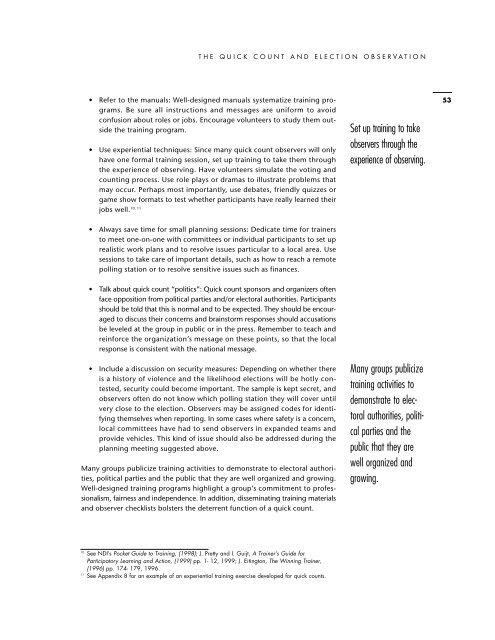The Quick Count and Election Observation
The Quick Count and Election Observation
The Quick Count and Election Observation
You also want an ePaper? Increase the reach of your titles
YUMPU automatically turns print PDFs into web optimized ePapers that Google loves.
THE QUICK COUNT AND ELECTION OBSERVATION<br />
• Refer to the manuals: Well-designed manuals systematize training programs.<br />
Be sure all instructions <strong>and</strong> messages are uniform to avoid<br />
confusion about roles or jobs. Encourage volunteers to study them outside<br />
the training program.<br />
• Use experiential techniques: Since many quick count observers will only<br />
have one formal training session, set up training to take them through<br />
the experience of observing. Have volunteers simulate the voting <strong>and</strong><br />
counting process. Use role plays or dramas to illustrate problems that<br />
may occur. Perhaps most importantly, use debates, friendly quizzes or<br />
game show formats to test whether participants have really learned their<br />
10, 11<br />
jobs well.<br />
Set up training to take<br />
observers through the<br />
experience of observing.<br />
53<br />
• Always save time for small planning sessions: Dedicate time for trainers<br />
to meet one-on-one with committees or individual participants to set up<br />
realistic work plans <strong>and</strong> to resolve issues particular to a local area. Use<br />
sessions to take care of important details, such as how to reach a remote<br />
polling station or to resolve sensitive issues such as finances.<br />
• Talk about quick count “politics”: <strong>Quick</strong> count sponsors <strong>and</strong> organizers often<br />
face opposition from political parties <strong>and</strong>/or electoral authorities. Participants<br />
should be told that this is normal <strong>and</strong> to be expected. <strong>The</strong>y should be encouraged<br />
to discuss their concerns <strong>and</strong> brainstorm responses should accusations<br />
be leveled at the group in public or in the press. Remember to teach <strong>and</strong><br />
reinforce the organization’s message on these points, so that the local<br />
response is consistent with the national message.<br />
• Include a discussion on security measures: Depending on whether there<br />
is a history of violence <strong>and</strong> the likelihood elections will be hotly contested,<br />
security could become important. <strong>The</strong> sample is kept secret, <strong>and</strong><br />
observers often do not know which polling station they will cover until<br />
very close to the election. Observers may be assigned codes for identifying<br />
themselves when reporting. In some cases where safety is a concern,<br />
local committees have had to send observers in exp<strong>and</strong>ed teams <strong>and</strong><br />
provide vehicles. This kind of issue should also be addressed during the<br />
planning meeting suggested above.<br />
Many groups publicize training activities to demonstrate to electoral authorities,<br />
political parties <strong>and</strong> the public that they are well organized <strong>and</strong> growing.<br />
Well-designed training programs highlight a group’s commitment to professionalism,<br />
fairness <strong>and</strong> independence. In addition, disseminating training materials<br />
<strong>and</strong> observer checklists bolsters the deterrent function of a quick count.<br />
Many groups publicize<br />
training activities to<br />
demonstrate to electoral<br />
authorities, political<br />
parties <strong>and</strong> the<br />
public that they are<br />
well organized <strong>and</strong><br />
growing.<br />
10<br />
See NDI’s Pocket Guide to Training, (1998); J. Pretty <strong>and</strong> I. Guijt, A Trainer’s Guide for<br />
Participatory Learning <strong>and</strong> Action, (1999) pp. 1- 12, 1999; J. Eitington, <strong>The</strong> Winning Trainer,<br />
(1996) pp. 174- 179, 1996.<br />
11<br />
See Appendix 8 for an example of an experiential training exercise developed for quick counts.


